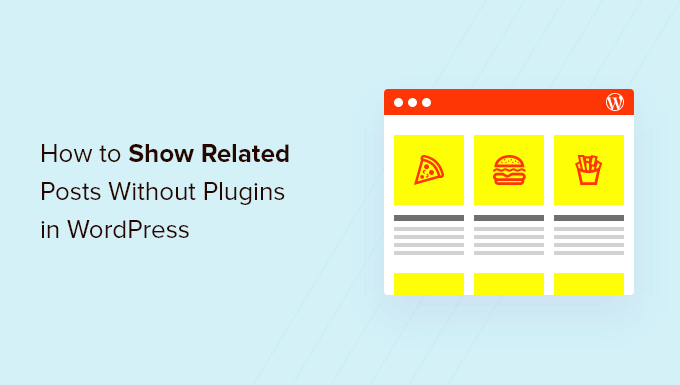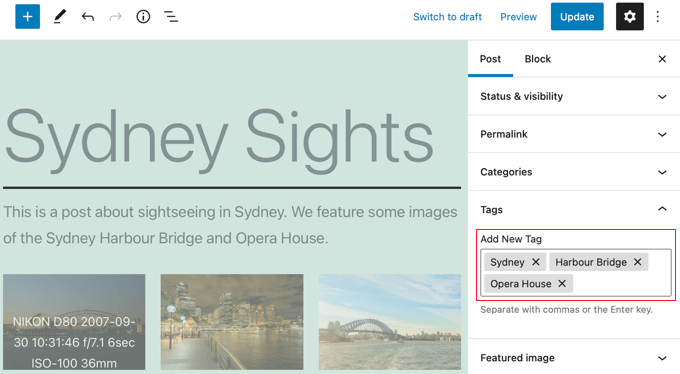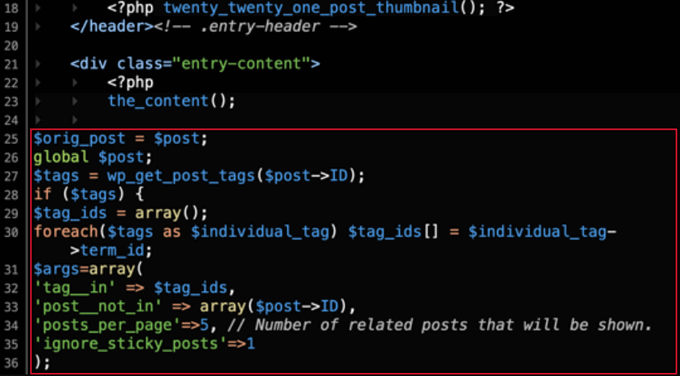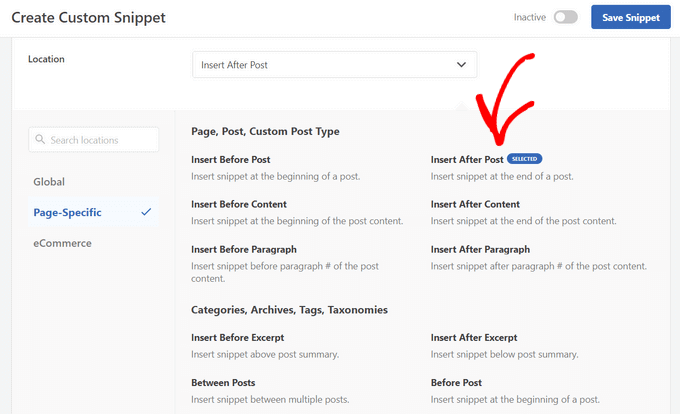Czy chcesz wyświetlić listę powiązanych postów na swojej stronie WordPress i wolisz używać kodu zamiast wtyczki?
W WPBeginner często podkreślamy, jak ważne jest importowanie odbiorców i zachęcanie ich do odkrywania treści. Jedną ze skutecznych strategii, którą widzieliśmy w niezliczonych udanych witrynach WordPress, jest wyświetlanie powiązanych postów.
Gdy odwiedzający Twój blog zakończą czytanie interesującego ich artykułu, zaoferowanie im listy powiązanych postów utrzyma ich zaangażowanie i pomoże im znaleźć nowe treści do przeczytania.
W tym artykule pokażemy, jak wyświetlić powiązane wpisy w WordPressie za pomocą kodu, bez konieczności korzystania z wtyczki.

Dlaczego warto wyświetlać wpisy powiązane w WordPress?
Kiedy twój blog WordPress zaczyna się rozrastać, użytkownikom może być trudniej znaleźć inne wpisy na ten sam temat.
Wyświetlanie listy powiązanych treści na końcu każdego wpisu na blogu to świetny sposób na zatrzymanie odwiedzających na twojej witrynie internetowej i zwiększenie liczby odsłon. Pomaga również poprawić widoczność twoich najważniejszych stron, wyświetlając najlepsze treści tam, gdzie ludzie mogą je łatwo znaleźć.
Jeśli nie jesteś obeznany z kodem, to łatwiej będzie ci wybrać jedną z wielu wtyczek WordPress do wyświetlania wpisów powiązanych bez kodu.
Ale jeśli kiedykolwiek zastanawiałeś się, czy możesz wyświetlać powiązane wpisy bez użycia wtyczki, podzielimy się dwoma różnymi algorytmami, których możesz użyć do generowania powiązanych wpisów z miniaturami za pomocą samego kodu:
Uwaga: Jeśli chcesz wyświetlać miniaturkę przy każdym powiązanym wpisie, upewnij się, że najpierw dodałeś obrazek wyróżniający do tych wpisów.
Metoda 1: Jak wyświetlić powiązane wpisy w WordPressie za pomocą tagów?
Jednym ze skutecznych sposobów na zlokalizowanie powiązanych treści jest wyszukiwanie wpisów, które mają te same tagi. Tagi są często używane do skupienia się na konkretnych szczegółach zawartych we wpisie.
Mając to na uwadze, możesz dodać kilka wspólnych tagów do wpisów, które chcesz ze sobą powiązać. Możesz je wpisz w polu “Tagi” w edytorze WordPress.

Po dodaniu tagów do twoich wpisów, następną rzeczą do zrobienia jest dodanie następującego fragmentu kodu do szablonu single.php twojego motywu.
Jeśli potrzebujesz pomocy w dodaniu kodu do twojej witryny, zapoznaj się z naszym przewodnikiem na temat wklejania fragmentów kodu z sieci do WordPressa.
1 2 3 4 5 6 7 8 9 10 11 12 13 14 15 16 17 18 19 20 21 22 23 24 25 26 27 28 29 30 31 32 | $orig_post = $post;global $post;$tags = wp_get_post_tags($post->ID);if ($tags) {$tag_ids = array();foreach($tags as $individual_tag) $tag_ids[] = $individual_tag->term_id;$args=array('tag__in' => $tag_ids,'post__not_in' => array($post->ID),'posts_per_page'=>5, // Number of related posts that will be shown.'ignore_sticky_posts'=>1);$my_query = new wp_query( $args );if( $my_query->have_posts() ) { echo '<div id="relatedposts"><h3>Related Posts</h3><ul>'; while( $my_query->have_posts() ) {$my_query->the_post(); ?> <li><div class="relatedthumb"><a href="<?php the_permalink()?>" rel="bookmark" title="<?php the_title(); ?>"><!--?php the_post_thumbnail(); ?--></a></div><div class="relatedcontent"><h3><a href="<?php the_permalink()?>" rel="bookmark" title="<?php the_title(); ?>"><!--?php the_title(); ?--></a></h3><!--?php the_time('M j, Y') ?--></div></li><!--?php }echo '</ul--></ul></div>';}}$post = $orig_post;wp_reset_query(); |
Ten kod szuka tagów powiązanych ze stroną, a następnie uruchamia zapytanie do bazy danych w celu pobrania stron z podobnymi tagami.
Gdzie należy umieścić kod? To zależy od twojego motywu, ale w większości przypadków powinieneś być w stanie wkleić kod do szablonu single.php twojego motywu po głównym wpisie i tuż nad sekcją komentarzy.
Jeśli korzystasz z motywu Twenty Twenty-One, tak jak my na naszej witrynie demonstracyjnej, dobrym miejscem do wklejenia kodu jest plik template-parts/content/content-single.php po nagłówku i zaraz po <?php the_content();.

Spowoduje to automatyczne wyświetlanie powiązanych treści w dowolnym wpisie WordPress. Będziesz musiał zmienić styl i wygląd powiązanych wpisów, aby dopasować je do twojego motywu, dodając własny CSS.

Wskazówka: Zamiast edytować pliki motywu, co może zepsuć twoją witrynę internetową, zalecamy użycie wtyczki fragmentów kodu, takiej jak WPCode.
WPCode umożliwia bezpieczne i łatwe dodawanie własnego kodu w WordPress. Ponadto zawiera opcje “Insertion”, które pozwalają automatycznie wstawić i wykonać fragmenty kodu w określonych miejscach na twojej witrynie WordPress, na przykład po wpisie.

Aby uzyskać więcej informacji, zapoznaj się z naszym przewodnikiem na temat dodawania własnego kodu w WordPress. Możesz również sprawdzić naszą szczegółową recenzję WPCode, aby dowiedzieć się więcej o wtyczce.
Metoda 2: Jak wyświetlić powiązane wpisy w WordPressie według kategorii?
Innym sposobem wyświetlania powiązanych treści jest lista wpisów, które znajdują się w tej samej kategorii. Zaletą tej metody jest to, że lista powiązanych wpisów prawie nigdy nie będzie pusta.
Podobnie jak w metodzie 1, musisz dodać fragment kodu do szablonu single. php twojego motywu lub we wtyczce fragmentów kodu, takiej jak WPCode. Aby uzyskać więcej informacji, zapoznaj się z Metodą 1 i naszym przewodnikiem na temat dodawania własnego kodu w WordPress.
1 2 3 4 5 6 7 8 9 10 11 12 13 14 15 16 17 18 19 20 21 22 23 24 25 26 27 28 29 30 | $orig_post = $post;global $post;$categories = get_the_category($post->ID);if ($categories) {$category_ids = array();foreach($categories as $individual_category) $category_ids[] = $individual_category->term_id;$args=array('category__in' => $category_ids,'post__not_in' => array($post->ID),'posts_per_page'=> 2, // Number of related posts that will be shown.'ignore_sticky_posts'=>1);$my_query = new wp_query( $args );if( $my_query->have_posts() ) {echo '<div id="related_posts"><h3>Related Posts</h3><ul>';while( $my_query->have_posts() ) {$my_query->the_post();?> <li><div class="relatedthumb"><a href="<?php the_permalink()?>" rel="bookmark" title="<?php the_title(); ?>"><!--?php the_post_thumbnail(); ?--></a></div><div class="relatedcontent"><h3><a href="<?php the_permalink()?>" rel="bookmark" title="<?php the_title(); ?>"><!--?php the_title(); ?--></a></h3><!--?php the_time('M j, Y') ?--></div></li><!--?php }echo '</ul--></ul></div>';}}$post = $orig_post;wp_reset_query(); |
Teraz zobaczysz listę powiązanych treści na dole każdego wpisu.
Jeśli chcesz zmienić styl i wygląd powiązanych stron, będziesz musiał dodać własny CSS, aby dopasować go do twojego motywu.
Przewodniki ekspertów dotyczące wpisów powiązanych w WordPressie
Chcesz dowiedzieć się więcej o wyświetlaniu powiązanych wpisów w WordPress? Sprawdź te pomocne poradniki dotyczące powiązanych wpisów:
- Jak wyświetlić wpisy powiązane w WordPress (krok po kroku)
- Jak wyświetlić powiązane wpisy tego samego autora w WordPress?
- Jak dodać wpisy powiązane w blogu WordPress?
- Jak wyświetlać losowe wpisy w WordPressie?
- Jak wyświetlić powiązane strony w WordPress?
Mamy nadzieję, że ten poradnik pomógł ci dowiedzieć się, jak wyświetlać powiązane wpisy z miniaturkami w WordPressie bez wtyczek. Możesz również dowiedzieć się, jak śledzić odwiedzających twoją witrynę WordPress lub zapoznać się z naszą listą 24 wskazówek, jak przyspieszyć twoją witrynę internetową.
If you liked this article, then please subscribe to our YouTube Channel for WordPress video tutorials. You can also find us on Twitter and Facebook.





kabir bairwa
I was trying to correct WordPress-related posts but it was not happening when I saw this code and I used this code in my WordPressfile so now my WordPress-related posts coming properly
WPBeginner Support
Happy to hear our guide could help you!
Admin
Jennifer
Is there a way to have related post based on the post title. I do not have tags and my categories really don’t do the trick since there is no distinction between them.
This would be of great help if you had a code to show related content based on the post title.
aman
I want code to display random posts and pages with thumbnail
WPBeginner Support
You would want to take a look at our guide below:
https://www.wpbeginner.com/wp-tutorials/how-to-display-random-posts-in-wordpress/
Admin
karan4official
Instead of using <? use <?php everywhere
WPBeginner Support
Thank you for your feedback, this article should currently be using the php version everywhere
Admin
Motahar Hossain
Thank you for your nice post.
Here “ignore_sticky_posts” should be used instead of “caller_get_posts”. Because “caller_get_posts” is deprecated.
WPBeginner Support
Thanks for pointing that out, we’ll be sure to look into updating the article
Admin
Frank
Can you direct me as to where to add what categories I would like to limit the related posts to?
WPBeginner Support
This method limits the posts to the category the post is in. To limit the categories you would need to create an if statement to exclude certain categories.
Admin
Greg
Is it possible where there are more than X related posts by category that are related that you can randomise say 3 posts?
WPBeginner Support
While it is possible, it would require adding far more to this, you may want to look into a plugin for that type of customization.
Admin
Akiode obasanjo
No CSS is added
luigi
Hi, is it possible to limit them by date? Show only those of the last year?
Luis
I found a way to make the smaller thumbnails, but it shows them in a column and not horizontally. How can this be modified?
Luis
The script is working well. The only problem I have is that the thumb-nails are very large. Would there be some way to make them smaller?
WPBeginner Support
Hi Luis,
It uses the default post-thumbnail size. You can create a new thumbnail size and then use it in the code like this:
<?php the_post_thumbnail('your-custom-size-name'); ?>1-click Use in WordPress
Admin
Ana
how to do for create a shortcode for this code, I created the function but I do not know how to return the print to the page.
Musarrof
Why I’m facing this problem. syntax error, unexpected end of file
Please help me.
Mike
Hello,
I’m a beginner in WorldPress.
I’d like to show Related Posts.
In the main menu I have Category A, and in Category A – Subcategories A, B and C. The posts are in Category A, but they can also be present in all 3 Subcategories.
When choosing one of the Related Posts something goes wrong and the posts from the initially chosen Subcategory don’t show correct anymore.
Anthony Reese
Thanks for the tutorial. This was incredibly useful and worked like a charm!
pawan singh
Hi Admin, Very informative article. I like your site because of simplicity and straightforwardness. All articles are to the point but when it comes to sharing the knowledge of code you become too technical. Just ignore the fact that much of the visitors are not coding expert. Wouldn’t it be much better if you just add 2or 3 more lines in your explanation to make it complete and easily understandable to all. Anyway, great article But I want to know which code or plugin is Wpbeginner using?
Ahmad
really helpful, thanks !
Tracy
what really sucks about your articles is you never actually say HOW to do something. It’s all well and good to tell me to put code into my single.php, but as a beginner I don’t know what that is or where to find it. You might want to think about putting this kind of critical information into your articles instead of assuming we know what it means, or that we have surfed every one of your articles to figure it out.
Victor Siyaya
I Agree. I have no idea where to paste this code too.
Rose
Thanks for the great post, very useful. I came across an error in the code so wanted to share in hope it may be useful for others in the future. The error was:
WP_Query was called with an argument that is deprecated since version 3.1.0! “caller_get_posts” is deprecated. Use “ignore_sticky_posts” instead.
So I simply replaced it and it worked fine. I am also using namespacing so I needed to change WP_Query to \WP_Query plus I changed the order of the below:
global $post;
$orig_post = $post;
Thanks again
Rose
sanjeev Kumar
sir
I am using the code of categories working properly but one thing is when on home page same category of 2 or 3 post then the link show balack but i want to show to show category which is next post
Luan
Hi,
Thanks for your post. I added the code in content-single.php and it worked. However, it displays as 1 column not 3 columns like your example. Could you please help me on this? I want my related posts to be displayed in 1 row, 3 columns. Thanks so much.
Claudio
Hello!
The first link on Aditional Sources, is broken.
Thank you by the code.
WPBeginner Support
Hi Claudio,
Thank you for notifying us. We have removed the broken link.
Admin